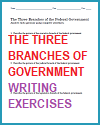The United States federal government, often simply referred to as the federal government, is the central government of the United States of America. It is a constitutional republic composed of three distinct branches: the legislative branch, the executive branch, and the judicial branch. Each branch has specific roles and responsibilities, and together, they work to govern the country, uphold the rule of law, and protect the rights and interests of the American people. Here is an overview of the key functions and roles of the United States federal government.
Legislative Branch (Congress):
- U.S. Senate: The Senate is one of the two chambers of Congress and is composed of 100 senators (two from each state). Senators are responsible for representing their states at the federal level, drafting and passing legislation, and providing advice and consent for various presidential appointments and treaties.
- U.S. House of Representatives: The House is the other chamber of Congress and is composed of 435 representatives who are apportioned based on each state's population. Representatives are responsible for drafting and passing legislation, especially bills related to taxation and government spending.
- Lawmaking: Congress has the exclusive authority to make federal laws, levy taxes, allocate government spending, and declare war. It plays a crucial role in shaping the nation's laws and policies.
- Oversight: Congress conducts oversight of the executive branch, ensuring that federal agencies and departments are operating within the bounds of the law and efficiently using taxpayer funds.
- Checks and Balances: Congress has the power to impeach and remove federal officials, including the President, through the impeachment process.
Executive Branch (The President and Executive Departments):
- President of the United States: The President is the head of the executive branch and the Commander-in-Chief of the U.S. Armed Forces. The President is responsible for enforcing and implementing federal laws, managing foreign affairs, serving as the chief diplomat, and making executive decisions.
- Executive Departments: There are 15 executive departments, each led by a Cabinet secretary appointed by the President. These departments oversee various policy areas, such as foreign relations, defense, health and human services, and more.
- Federal Agencies: Numerous federal agencies, bureaus, and commissions operate within the executive branch, carrying out specific functions, enforcing regulations, and administering government programs.
- Executive Orders: The President has the authority to issue executive orders, which have the force of law and are used to manage the executive branch and set policy direction.
Judicial Branch (Federal Courts):
- U.S. Supreme Court: The Supreme Court is the highest court in the federal judiciary. It has the authority to interpret the U.S. Constitution and federal laws, ensuring their constitutionality. The Court also resolves disputes between states and hears cases of national significance.
- Federal Courts: Below the Supreme Court are the federal district courts, courts of appeals, and specialized courts. These courts handle civil and criminal cases, including cases involving federal laws and disputes between parties from different states (diversity jurisdiction).
Protection of Civil Rights and Civil Liberties: The federal government is responsible for protecting individual civil rights and civil liberties through laws, regulations, and court decisions. This includes ensuring equal protection, freedom of speech, freedom of religion, and other fundamental rights.
Foreign Policy and National Defense: The federal government conducts foreign policy, represents the United States in international relations, and negotiates treaties and agreements. It is also responsible for national defense and the safety and security of the country.
Regulation and Oversight: The federal government regulates various aspects of American life, including commerce, environmental protection, healthcare, and financial markets. It also oversees the implementation of federal laws and programs.
Protection of Public Health and Safety: Federal agencies, such as the Food and Drug Administration (FDA) and the Centers for Disease Control and Prevention (CDC), work to protect public health and safety through regulation, research, and public health initiatives.
Economic Stewardship: The federal government manages the nation's finances, including taxation, budgeting, and economic policy, to promote economic stability and growth.
In summary, the United States federal government is the central governing authority responsible for making and enforcing laws, managing foreign relations, ensuring justice, and protecting the rights and interests of American citizens. It operates within a system of checks and balances to prevent any one branch from becoming too powerful and to uphold the principles of the U.S. Constitution.
|







